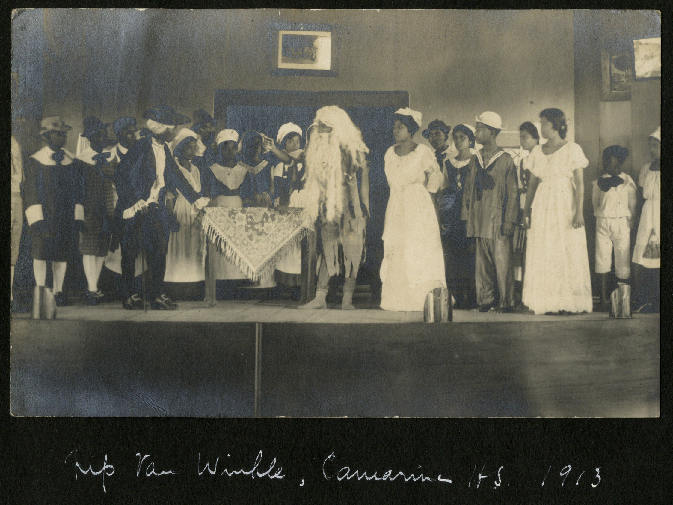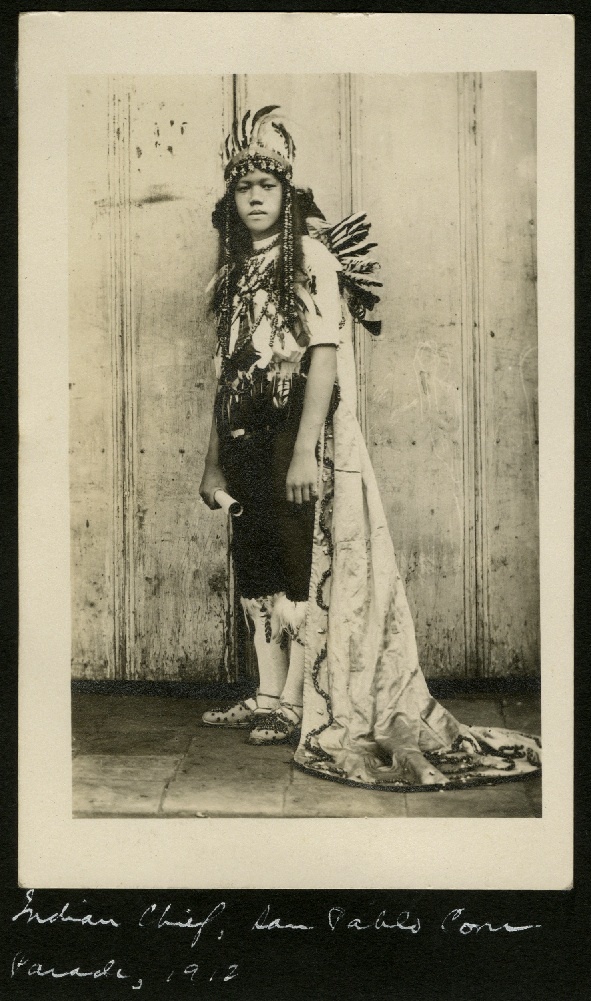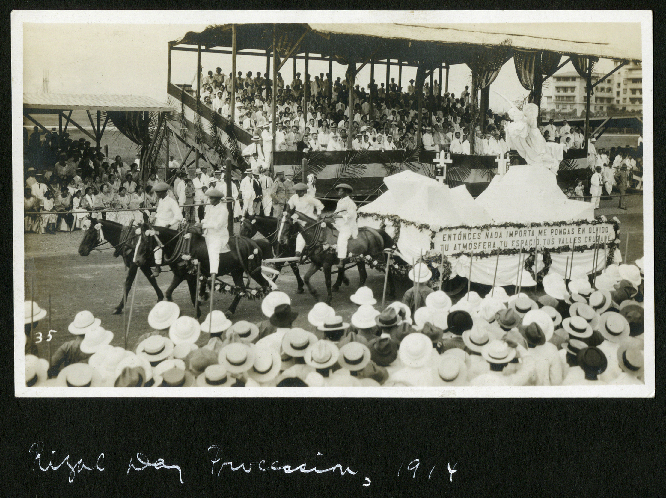III. Rewriting the Philippine Narrative
In order to justify American rule in the Philippines, the colonizers borrowed familiar literary and historical tropes to recreate the Philippine identity such that it fit into the American imperialist narrative. The colonizers' recreation of Philippine identities through education profoundly affected the way Filipinos viewed themselves. In his monumental work The Miseducation of the Filipino, historian Renato Constantino writes, "They learned no longer as Filipinos but as colonials. The ideal colonial was the carbon copy of his conqueror, the conformist follower of the new dispensation. He had to forget his past ... ."
In this photograph, a group of high school students act in a play adaption of Washington Irving's short story "Rip Van Winkle" (1819). The story begins in New York, shortly before the American Revolution against King George III of Great Britain. Rip, a happy-go-lucky, politically indifferent British-American colonial wanders into the wilderness accompanied by his dog, as he has done many times before. At the top of a mountain, Rip meets his Dutch ancestors, gets drunk with them, and falls into an uninterrupted sleep of twenty years—and sleeps through the revolution against the King. At first upset and confused, he slowly accepts the change and continues his idle life without complaint about the political transformation that he missed during his long slumber. Re-enacting this literary trope, the young Filipino high school students, then, are encouraged to accept the lost revolution and their new colonial power. In the words of Constantino, "The educational system introduced by the Americans had to correspond, and was designed to correspond, to the economic and political reality of American conquest. ... The American educational system was a subtle means of defeating a triumphant nationalism." As Rip's story renders the American Revolution a non-event, the Americans sought to rewrite the Philippine revolution against Spain as a non-event as well, thus justifying the change of power into American hands.
In visual representations of the Filipino, such as the early films produced by Thomas Edison as well as political cartoons and illustrations published in newspapers and magazines throughout the United States, the Filipino was often recasted as African American or Native American. Here, a young Filipino boy is dressed as an "Indian Chief," recalling the United States' own history of taking land and subjugating its natives to their rule. The colonizers normalized their experience in the Philippine tropics by employing familiar racialized tropes from their own history and transferring them to the Philippines. In his article "Imperialist Fictions: The Filipino in the Imperialist Imaginary," scholar and filmmaker Nick Deocampo asserts, "The imperialist imaginary, caught between mimesis and fiction, reveals the erasure of ‘real’ Filipinos either as they are replaced by ‘imagined’ ones, or worse, by their very absence. The imaginary annihilates the actual object it represents." For the colonizers, the Filipino was a familiar racialized Other whom the American had already imaginatively subjugated.
Reimagining the Filipino as African American or Native American also influenced the set-up of the educational system in the Philippines. A number of industrial training schools in the Philippines were modeled after the Hampton Normal Institute for African Americans and the Carlisle Indian Industrial Training School and the Tuskegee Institute. Middle-class Anglo-American values and practices were an integral part of the curriculum to "Americanize" students. In her book Empire's Proxy: American Literature and U.S. Imperialism in the Philippines, scholar Meg Wesling explores the eventual decision of the American colonizers to focus on spreading academic rather than industrial curricula in schools. In the Philippine schools, the English language and American literature functioned to mold the Filipino into an obedient colonial subject. "It was thus the role of the literary to perform the twin functions of mental discipline (English is the new Latin) and emotional discipline, transforming Filipinos from recalcitrant, 'savage,' or resistant antagonists into colonial subjects imbued with the Protestant values of 'Love of Country, Self-Sacrifice, Devotion to Truth and Duty, and the Appreciation of the Beautiful.'" Crone's photographs capture the process of such cultural transformation—the unruly Filipino now loves to play baseball; General Aguinaldo has been pacified enough to pose and smile for the camera; the Filipino students learn proper attitudes toward revolution and their place as American colonial subjects through putting on a Rip Van Winkle play adaptation. The rationale is clear: the Filipino must learn assimilation into Anglo-American culture, much like African Americans and Native Americans back home.
As the Philippine population became increasingly fluent in English, school and public libraries brimmed with literary and historical texts written in English, now accessible to the English-educated public. Wesling notes that there were no books written by any Filipino authors available in the libraries organized by the Americans—not even the translated works of Filipino revolutionary, poet, and writer José Rizal (1861-1896), despite the fact that the Americans sought to reclaim him for their purposes. Rizal, often credited for instigating the Philippine Revolution, wrote two novels in Spanish, Noli Me Tanegre and El Filibusterismo, in which he critiqued the colonial order of the Philippines under Spain. While Rizal took up the pen to question the legitimacy of Spanish rule and discouraged a violent uprising (his argument being that the Philippines was not yet ready), his name and novels did inspire the militant forces, headed by Andrés Bonifacio and later General Emilio Aguinaldo, to challenge the Spanish rule, eventually leading to the revolution. Although many members of Bonifacio's Katipunan forces and Bonifacio himself were illiterate, they found inspiration in Rizal as a key figure in developing a sense of Philippine nationalism in the face of the Spanish colonizers.
The Americans sought to appropriate Rizal for their imperialist narrative, capitalizing on Rizal's critique of military uprisings against the Spanish colonial regime. By elevating him to the status of "National Hero" and constructing a monument for him at the place of his execution by the Spanish colonizers (pictured in the political cartoon of Crone "The Pioneer"; see section I of the exhibit), the Americans, in the words of General James F. Smith, the 1905 secretary of public instruction in the Philippines, recast Rizal as "the apostle of evolution, not of revolution." As Smith put it, "Who will say that looking into the great beyond he did not see his people reach the wished for goal under a tutelage stronger, more powerful and more compelling than his own?"
In Crone's photo album, the "Rizal Day Parade" photograph is posted next to other photos of floats draped in the American flag. Through this aesthetic arrangement, Crone equates a float containing a verse of Rizal's poetry with other patriotic representations of the United States. The side of the float quotes from Rizal's poem "Mi último adiós” (“My Final Farewell”), written right before his execution at the hands of the Spaniards. The quote reads, "Entonces nada importa me pongas en olvido. / Tu atmósfera, tu espacio, tus valles cruzaré" ("Then it matters not that thou shouldst forget me: / Thy atmosphere, thy skies, thy vales I'll sweep"). The appropriation of Rizal's poetry encourages the act of forgetting—which translates into the encouragement that the American colonial rule in the Philippines be accepted as benign.



